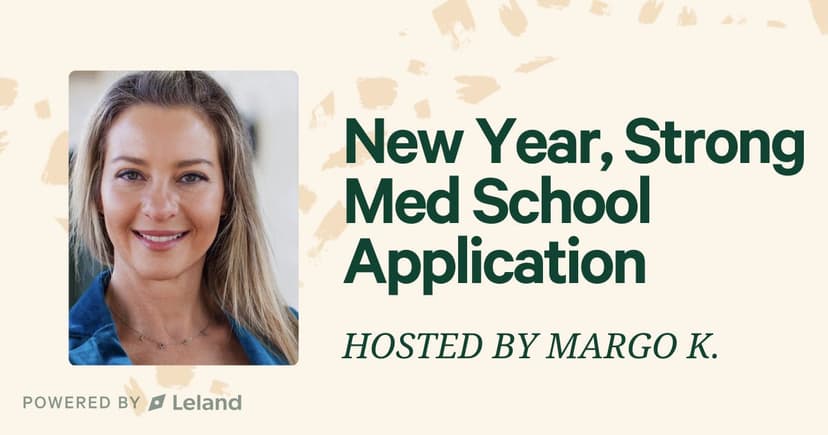How to Get Into Medical School: The Complete Guide (2025)
Dreaming of med school? Learn how to get in – from MCAT prep to interview success – with expert advice for students, grads, and non-traditional applicants.

By Krysta F.
Your Favorite Med School Coach's Favorite Med School Coach
Posted August 7, 2025

Join a free event
Learn from top coaches and industry experts in live, interactive sessions you can join for free.
Table of Contents
The rumors are true: getting into medical school IS competitive. Each year, tens of thousands of smart, qualified students apply, and more than half get rejected. But with the right strategy – one that highlights the impact you hope to make as a physician and the ways in which you’ve prepared yourself – it’s completely possible that you can earn your spot as a future physician.
Over the last five years, I’ve worked with hundreds of students and completed thousands of individualized advising appointments guiding applicants through the medical and graduate school application process. In my coaching, I’ve helped students gain admission to some of the most prestigious programs in the world: Harvard, Johns Hopkins, UCLA, Duke, and others. But at the end of the day, what really matters isn’t prestige; it’s fit. There is no such thing as the “right” medical school; only the medical school that is right for you. While your scores and demonstrating your competencies are part of the equation, it’s important to prioritize your long-term goals and needs when applying, choosing programs that will support you as you enter this next exciting chapter of your life.
Whether you're a first year pre-med, a gap year applicant, or coming from a non-traditional background, this guide breaks down everything you need to know about prepping for the med school application process: from GPA targets and MCAT (Medical College Admission test) prep to personal statements and interviews.
How Hard Is It to Get Into Medical School?
Getting into medical school is difficult, but not for the reasons most applicants think. According to the AAMC, the national acceptance rate hovers around 43% – and it’s even lower for applicants targeting MD-only programs or top 20 schools.
That means strong grades and MCAT scores alone aren’t enough. Every cycle, thousands of applicants with 3.8+ GPAs and 510+ MCATs get rejected. Why? Because getting into medical school is about more than the numbers. It’s about your judgment, motivation, maturity, and readiness to take on the emotional and ethical weight of becoming a physician.
Here’s what makes the medical school process uniquely competitive and what most students underestimate.
- Academic excellence is just the starting line. Schools don’t expect great stats, they require them. The average accepted medical college admission test score is 508, but top-tier schools often expect 515+. Likewise, a science GPA of 3.7+ is the norm for competitive applicants. These figures are looked at in the context of the rest of your application, of course, but they are very important on their own as well.
- Building a competitive application takes years. You don’t “apply to med school”; you build toward it over 2-4+ years. That means sustained, meaningful experience across four core areas: 1) clinical exposure, 2) shadowing, 3) research, and 4) service and leadership. Many applicants also take a gap year to deepen these experiences and apply with a more mature, intentional application.
- Schools admit people, not profiles. Medical schools use holistic admissions not just to be fair, but to build a class that works together, reflects diverse perspectives, and thrives in a demanding, high-stakes environment. This means that your story really does matter – who are you, why medical school, and why now? Your personal statement, letters of recommendation, secondaries, and interview all help AdComs answer one question: Would I trust this person on my clinical team someday? If your stats are lower, this part of the application is your chance to stand out.
- There are more applicants than seats each year. Even if you're qualified, there simply may not be room. Some schools receive 10,000+ applications for 100-200 spots. That math is brutal. It’s also why strong candidates still get waitlisted or rejected. But you can increase your chances by applying broadly, intentionally, and early, and by working with an expert to put together the strongest possible version of your candidacy.
In summary, the best and worst part about applying to medical school is that there is no “one right way” to do it. For that reason, it’s important to put your best foot forward in every part of the process, and commit to sharing your unique point of view and experiences throughout your application.
What Medical Schools Are (Actually) Looking For
Medical schools don’t admit perfect resumes: they admit future physicians. Every part of your application should help answer one central question: Is this person prepared to become a competent, compassionate doctor who can handle the emotional, academic, and professional demands of medicine? To get there, AdComs evaluate five key dimensions and the strongest applicants don’t just “check the boxes.” They show depth, intention, and growth in each.
When writing about your experiences, it’s best to center your descriptions around the AAMC Competencies. This list, adopted by MD and DO schools alike, details the skills and qualities AdComs are looking for in incoming medical students. By centering these competencies in your reflection of your experiences, you can show committees that you’ve developed the skills that are most sought after in applicants.
Here’s what to think about and look out for as you’re putting together your candidacy.
1. Academic Readiness
Your academic performance proves you can handle the intensity of med school coursework – especially in the sciences. But it’s not just about your GPA. AdComs are trained to assess:
- Cumulative and science GPA (most MD admits are 3.7+, but upward trends matter too)
- Course rigor and progression (Did you take advanced bio/chem/physics? How’d you bounce back from setbacks?)
- Consistency (One bad semester? Fine. A pattern of struggle without context? Red flag.)
For the academic sections of your application, admissions officers are asking themselves, “Can this student succeed in our curriculum without burning out? Have they shown the discipline and resilience med school requires?” If your undergraduate program doesn’t fully demonstrate your capabilities, don’t worry—you’re not out of the running! Excelling in a Master’s or post-bacc program can help you to boost your GPA, demonstrating that you’re capable of the academic excellence med schools are looking for.
See: What GPA Do You Need to Get Into Medical School?
2. MCAT Scores & Section Expectations
The MCAT is important because it’s the only standardized comparison point across all applicants. While 508 is the national average for accepted students, top schools often look for 515+. That being said, there are many programs that are within range for applicants below the average as well. In general, if you can score above 500, and the rest of your stats and experiences are strong, you’re still in the game!
Some important things to note: 1) Some schools screen by section, not just total score. 2) They often compare first attempt vs. retakes, not just the highest score. 3) A great MCAT can’t rescue a weak application, but it can solidify a strong one or make up for gaps in other areas. With your MCAT score, AdComs want to know that you have demonstrated critical thinking, scientific reasoning, and test-day poise under pressure.
See average scores for all the top schools here: The 20 Best Medical Schools in the US (T20): Acceptance Rates, MCAT Scores, & GPA
3. Clinical Experience & Shadowing
Schools want to see that you’ve spent time in the healthcare world – not just because it looks good, but because it proves you understand the realities of medicine. You don’t need 1,000 hours but you do need real exposure and reflection. That means shadowing experience under physicians, gaining hands-on patient experience, and prioritizing depth over prestige. What you learned, how you talk about it, and how it connects to your background and goals matter far more than the setting or number of experiences.
Again, this is a GREAT place for you to highlight your competencies. Consider opportunities that will help you learn how to build relationships with patients, build your teamwork and collaboration skills, and challenge yourself to learn and grow.
Expert Tip: Both medical school and medical careers can be grueling. In looking for real experience, admissions officers are trying to understand if you know what it means to care for patients – physically, emotionally, and mentally – and if you really want this for yourself. If you do, you’ll be much more likely to succeed.
4. Research, Leadership, & Service
Research is not required for every applicant, (unless you want to pursue medical research as a career) but intellectual curiosity is. Leadership and service, however, are non-negotiable.
What matters most is consistency, ownership, and impact. Schools want students who show up, persist through challenges, and care about the world around them. Don’t take the “checkbox” approach; schools know when you’ve just been going through the motions. Instead, curate a resume that reflects your commitment to your values and interests by choosing several deep and meaningful experiences where you spent significant time and made a real difference.
A good way to approach this is to spend time thinking about problems in the world you want to help solve – and then get out there and do something about it! Join a student organization where you get to tutor kids in math and science. Volunteer with your local refugee center. Seek out research that focuses on reproductive health. Whatever your interest is, find ways you can contribute to it now. This is a great way to add personality to your application and to show AdComs that you’re already working towards making a difference.
For more, read: Research Hours for Medical School: How Many You Need & How to Get Them
5. Character & Fit – Are You Mature and Emotionally Intelligent?
This is the wildcard that sinks many high-GPA, high-MCAT applicants. Med schools train people to step into life-or-death roles. AdComs are asking themselves if they can trust an applicant on a medical team, if patients will trust them, and if they’ll be a positive contributor to the medical school class.
This is where your personal statement, letters of recommendation, secondaries, and interview come into play. They reveal who the person is underneath the numbers – self-awareness, emotional intelligence, judgement under pressure, communication, humility, and resilience. Are you compassionate, mature, and emotionally attuned enough to handle the demands of the job? Do you have the intellectual horsepower required to succeed in a medical school program?
“Fit” doesn’t mean personality; it means that you understand the mission, values, and culture of the school and that you see your own values reflected in the school. They want to see the quantitative and qualitative skills that give you the best shot of succeeding in medical school and in a medical career. Working with a coach to make sure that your materials can help to ensure that your readiness is well reflected in every part of your application.
What to Do During College (or Before You Apply)
The best medical school applications don’t come together overnight—they’re built intentionally over 2-4+ years, often with twists, setbacks, and growth along the way. Whether you're an undergrad, a post-bacc student, or in a gap year, here's what to focus on at each stage to give yourself the strongest shot at acceptance.
Freshman to Sophomore Year
Starting strong leads to success down the road. Your job here isn’t to impress med schools: it’s to become a strong future applicant with a unique point of view. Build your foundations so that when you are ready to apply, you have all the pieces in place.
What to focus on:
- GPA may not be everything, but it matters. Don’t overload your schedule and protect your GPA, especially in bio, chem, and math.
- Get an academic plan mapped out, including prereqs, MCAT timing, and potential gap year options.
- Explore early clinical exposure. Volunteer at a hospital, shadow a local doctor, or get CPR/EMT certified. Even 2-4 hours/week at this point in your timeline is helpful.
- Build relationships for letters of recommendation. Go to office hours. Ask to help with research. Let professors get to know you. These relationships will be very important for your letters of recommendation but also just for your career in medicine. Build them with intention.
- Start journaling experiences. Write down reflections after shadowing or volunteering. Make note of the competencies you’re developing in each of these experiences. These notes will become gold for your personal statement later.
- Find community. Join a couple pre-med or health-related clubs. Volunteer with a local organization that allows you to connect with communities that you’re passionate about serving. Doing this will not only strengthen your resume, it will help you to find peer support and motivation while also adding personality to your application.
Not sure if medicine is right for you? Don’t panic; while you should start to make a decision during your sophomore year, it’s ok to change your mind. Also, there is no perfect major to choose. While most pre-med students choose ones like biology, chemistry, or other health-related subjects, at the end of the day, you should choose a major you will excel in and more importantly: one that you genuinely enjoy. As long as you get the prerequisites you need to apply, you have a lot of options.
Expert Tip: You will succeed as a medical school applicant because you are you, not because you look like every other candidate. When thinking through the shadowing, research, clinical, and extracurricular activities that you want to be involved in, pick ones that are close to your passions and goals. What do you care about? Where do you really want to have an impact? What is something you could be involved in for a long time? That’s a great place to start.
Junior Year
This is often the most intense (and decisive) year. You’re deep into upper-level science classes, gaining experience, and likely starting to prepare for the MCAT. Now’s the time to clarify your “why” and get ready to explain it.
What to focus on:
- Finalize your prereqs and academic story. If you’ve had a GPA dip, this is your moment to turn the trend upward.
- Start (or deepen) meaningful activities. Stick with 1-2 clinical or service commitments you actually care about. Remember that depth > breadth here.
- Begin MCAT prep. Ideally, you’ll take the exam in spring or early summer of junior year if you plan to start med school right after you finish your undergraduate degree. Build a realistic 3-6 month study plan, then find an MCAT tutor to help you ace the test.
- Continue building those relationships. Reconnect and/or form new connections with professors, physicians, supervisors, volunteer coordinators, and advisors who can serve as important supports during your application process and can speak to your skillset in their letters of recommendation.
- Track your experiences in a running log. Use the AAMC’s “Work & Activities” section categories so it’s easier later. And (I know you’re sick of hearing it!), but tie in those competencies!
Senior Year (or Gap Year)
If you’re applying during your senior year, this is go-time. If you’re taking a gap year (which many applicants do; the average age of an M1 is 24!), this is when you double down on your narrative and sharpen any weak spots.
What to focus on:
- Take the MCAT (if you haven’t already). Your test score drives your school list, so give yourself time to retake if needed.
- Apply when you’re your best applicant. There is LOTS of information online about the importance of applying early. While AMCAS opens in May, and submitting earlier means that schools will see your application sooner, there is a lot more flexibility in the timeline than you might think. While applying by the end of June is ideal, you can still have a competitive application if you’re in by the end of August.
- Write your personal statement and activities section. These are often the most time-consuming (and important!) parts of the app. Start drafting early and get feedback from someone who understands what AdComs want.
- Secure strong letters. Get initial commitments by February or March and then follow up in April or May. Many recommenders will want to see your personal statement and resume. Additionally, I recommend highlighting the competencies you want them to speak to in their letter, providing as much detail as possible for how you feel you developed that skill(s) during your time with them.
- Keep gaining experience. Whether it’s full-time research, clinical work, teaching, or community service, your activities this year still matter.
- Prep for secondaries and interviews…after your primaries are in. This is a marathon, not a sprint. Take time to rest between each step in the application process.
How to Build a Standout Medical School Application
AMCAS Application Overview
The AMCAS (American Medical College Application Service) is your primary app for MD programs – it opens in May, and you can submit starting early June. Most admissions experts recommend submitting by mid-June for the best chances due to rolling admissions. HOT TAKE: you can still put together a competitive application and submit by August. Quality is always, Always, ALWAYS more important than timeline.
Core Components of the Primary Medical School Application:
- Transcripts and course info
- MCAT scores
- Work & Activities section (up to 15 entries)
- Personal statement
- Letters of recommendation
- School list
Personal Statement
This is the most important narrative in your application. It’s where you explain why you want to be a doctor and why you’re ready. Great essays show a clear “why medicine?” arc, include several personal stories that shaped you, tie your past into your future in medicine, and include deep reflections on what your experiences have taught you.
The most common pitfalls I see include using overly generic statements like “I want to help people”, rehashing the experience on your resume, overexplaining trauma or erring on the side of too dramatic, or talking more about doctors or other people in your life instead of yourself. Don’t be afraid to self-promote here – this is your chance to show what you’ve done and where you’re going, and there is a right way to do so. If you’d like a second pair of eyes on your personal statement, reach out. I’d be happy to help.
Expert Tip: Your end goal here is to make the reader believe that medicine isn’t just what you want to do, it’s who you’ve become through your experiences.
Read: How to Write a Powerful Personal Statement for Medical School
Work & Activities
You’re allowed up to 15 entries, but that doesn’t mean you need all 15 (although you definitely can). Quality > quantity. You’ll also choose 3 experiences as “most meaningful” and write additional reflections for those. Don’t skimp on extracurricular activities – more is not necessarily better, but having meaningful ones that are authentic to you and your goals and that you’ve been involved with for a long time can make a big impact on your application.
Here are some examples of activities to include:
- Clinical exposure (volunteering, scribing, hospice work, etc.)
- Shadowing
- Research
- Leadership roles
- Service and community involvement
- Teaching, tutoring, or peer mentorship
- Employment or gap year experiences
For strong entries, start with a clear and active description of what you did, quantify the impact where possible, and reflect on what you learned and how it shaped you. Don’t just tell the story, explain the “why” and “so what.”
Read: Crafting a Powerful AMCAS Most Meaningful Experience Essay
Letters of Recommendation
Strong letters can significantly elevate your application; weak or generic ones can quietly tank it. Most schools require 3-5 letters and some have stricter instructions on who those should be. Aim for 1-2 science faculty, 1 clinical/research mentor, and 1 character or leadership reference.
To get the best letters possible, make sure to ask your recommenders early and provide them with a resume, your personal statement draft (if done), and a couple of bullet points of example characteristics and/or examples they could pull from. Choose people who know you well, not just big names. You want people who understand you deeply and can be big advocates for you if at all possible, not people who will passively support your goals.
If you do go to a school that has a pre-health committee, you may be able to get a specific type of medical school recommendation, the committee letter (more available here). Talk to your pre-health professions advisor if you have one available to find out specifics for your program.
Secondaries
Secondaries are the most underrated part of the application, and often the most time-consuming. Each school sends you a unique set of prompts (usually 2–4 per school), often within 1–2 weeks of receiving your primary app.
With secondaries, schools are looking for:
- How well you understand their mission and values
- Why you're a good fit for their curriculum, culture, and location
- How your background, perspective, or goals align with what they offer
- Clarity of thought, self-awareness, and professionalism
Remember, schools don’t just want to hear why you love them – they want to know why they’re the right place for you based on your story, goals, and values. It’s about a mutual fit between you and the program. Spend time reflecting here; it’s the specifics that make the most difference.
Interviews
Getting a medical school interview means you’ve cleared the first big hurdle and the committee wants to see who you are beyond the page. The interview isn’t just a formality; it’s where schools evaluate your maturity, communication skills, emotional intelligence, and overall fit for the profession.
Expect questions about your motivations for medicine, how you’ve handled challenges, and what you’ve learned from key experiences. You’ll also need to show self-awareness, humility, and a genuine understanding of what a career in medicine actually looks like.
Here are the most common interview formats:
- Traditional: One-on-one or panel conversations focused on your journey, values, and experiences
- MMI (Multiple Mini Interview): Rotating short stations testing ethics, problem-solving, and communication
- Hybrid: A mix of MMI, traditional, or asynchronous video components
Expert Tip: Your stories matter more than soundbites. Practice answering questions out loud, do mock interviews, and come prepared with 2–3 personal examples that show reflection, empathy, and character. The best interviews feel like real conversations with a future team member.
Medical College Admissions Test
The Medical College Admission Test (MCAT) is a standardized exam required for admission to nearly all medical schools in the U.S. and Canada. Administered by the AAMC, it’s designed to assess your critical thinking, problem-solving skills, and knowledge of natural, behavioral, and social sciences – all of which are foundational for success in medical school. The tl;dr for the MCAT is to study early and often. Don’t underestimate the time it will take to reach a top score, especially if you’re aiming for a top-ranked program.
The MCAT consists of four sections:
- Chemical and Physical Foundations of Biological Systems
- Critical Analysis and Reasoning Skills (CARS)
- Biological and Biochemical Foundations of Living Systems
- Psychological, Social, and Biological Foundations of Behavior
Each section is scored from 118 to 132, with a total score range of 472 to 528. The median score is around 500, but medical schools are highly competitive so most applicants shoot for a 510 or higher.
Medical schools weigh your MCAT score heavily during the admissions process. However, it's not the only factor. As mentioned above, GPA, extracurriculars, clinical experience, and personal statements also matter.
Tips for Med School: Choosing the Right Program
Choosing where to apply is a much more strategic decision than most applicants think. The list affects where you get in, true, but also where you will spend the next several years of your life, what extracurriculars you’ll have access to, who your classmates will be, and much more. Here’s how to build your school list.
- Start with mission fit, not just the rankings. Medical schools aren’t interchangeable. Each one has its own mission, culture, curriculum, and priorities. If your application doesn’t align with what they care about, even strong numbers won’t get you far. Ask yourself:
- Does this school focus on research? Primary care? Health equity? Rural medicine?
- Are you drawn to innovation, global health, or a community-based approach?
- Will your clinical and volunteer experience resonate with their values?
- Use data to categorize your schools. A good medical school list includes a mix of reach (your stats are slightly below their median), target (your stats match their average), and safety (your stats are comfortably above average) schools. You should also factor in in-state vs. out-of-state acceptance rates (for public schools), average GPA/MCAT scores of admits, and overall selectivity.
- Pay attention to geography and residency bias. Many public MD schools prioritize in-state applicants (sometimes >85% of the class). Unless you have strong ties to the region or they’re known to consider out-of-state medical students, your chances may be lower at these schools than in-state institutions. Also consider if you want to train near family or potential residency networks and what types of locations you would be happiest in.
- Look into the curriculum and learning environment. Not all medical schools teach the same way. Some schools run on pass/fail vs. tiered grading, some have early patient contact vs. traditional preclinical/clinical split, and some are run on Problem-Based Learning (PBL), vs. flipped classrooms or lectures. You’ll perform better and be happier in an environment that suits your learning style. Talk to mentors, current medical students and find information online to figure out what kinds are best for you.
Common Mistakes
I’ve seen thousands of applicants apply to medical schools. Here are some of the most common mistakes and traps that applicants fall into, and how to avoid them.
1. Thinking great stats are enough to guarantee admission. Each year, thousands of applicants with 3.9 GPAs and 515+ MCATs are rejected. Med schools want well-rounded, emotionally intelligent, self-aware future doctors, not just test-takers. Instead, build a story-driven application that shows your judgment, values, and readiness across every component, not just the quantitative ones.
2. Rushing your application. AMCAS opens in May, but it’s very common that students may not apply until later in the summer. It’s always better to make sure that your application is READY and speaks to your schools than it is to stick to a timeline. That being said, ideally your application will be in by the end of June, but even if you submit by the end of August, it’s still possible to be admitted. When it comes to secondaries, plan to return them to schools within 2-3 weeks of receiving them.
3. Writing a generic personal statement. “I like science and want to help people” is something that is (hopefully) true of every medical school applicant. For that reason, it’s important for you to dig deeper for your statement. Schools want reflective, specific stories that show how your experiences shaped your desire to practice medicine. Focus on 2-3 key moments that shifted your perspective and helped you to develop your competencies.
4. Copy-pasting secondaries across schools. Secondaries are about fit. If your answers could apply to any school, they’ll fall flat. AdComs can spot filler answers instantly. While you can repurpose stories, it’s important to tailor each secondary to the school’s mission, programs, and culture and clearly connect their values to your goals.
5. Not practicing interviews. Even top applicants stumble in interviews because they haven’t practiced out loud. Med schools aren’t just evaluating your answers, they’re assessing judgment, maturity, and communication under pressure. Do at least two mock interviews (including MMI if needed) and get feedback from someone who understands med school admissions. This is the best prep tool that you have at your disposal; make the most of it.
6. Applying to the wrong mix of schools. A school list full of reach programs or prestige picks is a recipe for disappointment. Most applicants need a balanced list with a thoughtful mix of MD, DO, and mission-fit schools. Build a data-informed list with ~15-25 schools that include reaches, targets, and foundation schools aligned with your profile and story.
What to Do if You Have a Low GPA or MCAT Score
A lower GPA or MCAT doesn’t automatically take you out of the running, but it does mean you need to be more strategic, self-aware, and proactive in how you approach the rest of your application.
The first thing you need to do is assess whether your numbers are low overall or just low relative to the schools you’re targeting. A 3.4 GPA and 506 MCAT might be below average for top MD programs, but well within range for many DO schools or mission-driven MD programs that value service and upward trends.
For a Low GPA…
If your GPA is the concern, focus on demonstrating academic resilience. That might mean taking additional upper-level science courses, enrolling in a post-bacc program, or earning a strong science GPA in a master’s program. Use your personal statement or secondaries to briefly acknowledge the context—whether it was illness, family challenges, or a late start – and then focus on what changed and how you’ve grown. Never make excuses; instead, own it and show how you’ve adapted.
For a Low MCAT Score…
If your MCAT is the issue, be honest about whether it reflects your true ability. A retake with improved prep (especially using official AAMC materials and full-length exams) can make a major difference. But if your test history is maxed out, shift focus to what you can control: outstanding clinical experience, meaningful service, strong letters of recommendation, and a thoughtful school list that includes DO programs and MD schools with more holistic review.
If you do have a lower GPA or MCAT score, it’s extra important to make sure the rest of your application is as tight as possible. I can help provide personalized advice tailored to your application, background, goals, and target schools to give you the best possible chance of success.
Bonus Tips for Getting Into Medical School
Reverse-Engineer the “Competence + Character” Composite
Top med schools don’t admit future doctors, they admit future leaders of medicine. That means intellectual horsepower alone won’t cut it. Build your narrative around two axes:
- Competence = academic excellence, research, MCAT, clinical experience
- Character = leadership, grit, reflection, humanism
For every core experience you list (research, volunteering, clinical work), explicitly frame how it reflects both. For example, don’t just say you worked in a free clinic; show how you identified a bottleneck, created a solution, and reflected on its human impact. This level of intentional framing is rare and will set you apart in both your AMCAS essays and interviews.
Craft a Primary Care and System-Level Dual Thesis
Med schools today want applicants who see beyond the stethoscope. They’re not just evaluating if you can treat a patient, they’re asking: will you improve the system?
Develop a dual thesis that connects 1) a personal, patient-centered reason for pursuing medicine and 2) a clear system-level insight or interest (e.g., rural health, policy, health tech, equity).
The best applicants tie a personal story to a systemic challenge, and then layer in coursework, internships, or research that shows early traction toward solving it. This thesis should be visible across your personal statement, most meaningful activities, and secondaries.
Pre-Wire Your Letters of Recommendation Like a Political Campaign
Top-tier letters don’t just describe, they need to fully and enthusiastically endorse you. The best ones make AdComs feel like not taking you would be a mistake. Start cultivating recommenders 9-12 months before applying. Ask each one strategically to highlight a distinct set of traits that complement the rest of your application (e.g., analytical skill, empathy, leadership under pressure). Before they write, give them:
- A one-pager with your personal statement draft
- A list of 2–3 stories/traits you’d love them to speak to
- A short paragraph summarizing why their voice matters in your app’s narrative
This transforms LORs from generic praise into a deliberate chorus that reinforces your candidacy from multiple angles. The recommendation component is so important because it’s the only part of your application that doesn’t come from you. What they say can make or break your candidacy, so make the most of it and set them up for success.
The Bottom Line
Getting into medical school is one of the most challenging application processes out there, but it’s not impossible. Success isn’t about perfection; it’s about strategy, self-awareness, and consistency over time. The strongest applicants aren’t always the ones with perfect stats, they’re the ones who understand what admissions committees actually care about: growth, judgment, emotional intelligence, and real-world readiness for medicine.
No matter where you’re starting (a freshman pre-med, a non-traditional applicant, or someone bouncing back from setbacks) there is a path forward. With smart planning, the right support, and a clear story, you can absolutely become the kind of candidate med schools want to admit. and the kind of doctor patients will trust.
You got this!
Read these next:
- How Long is Medical School – A Year-by-Year Breakdown
- Is Med School Worth It? Weighing the Pros and Cons
- 6, 7 and 8-Year Accelerated BS/MD Programs (2025)
How to Get Into Medical School – FAQs
What is the Medical College Admission Test (MCAT) and why is it important?
- The Medical College Admission Test (MCAT) is a standardized exam required by nearly all U.S. and Canadian medical schools. It assesses your understanding of science concepts, critical thinking, and problem-solving skills. Admissions committees at both MD and osteopathic medicine programs rely heavily on MCAT scores when evaluating medical school applications.
Should I apply to multiple medical schools?
- Yes. Most successful medical school applicants apply to multiple medical schools to increase their chances of admission. Application numbers vary, but it's common to apply to 15–25 schools, including a mix of reach, target, and safety options.
What do medical school admissions committees look for?
- Medical school admissions committees consider more than just grades and test scores. They evaluate your undergraduate career, science classes, clinical and research experience, personal interests, leadership, and letters of recommendation. Your personal statement and performance in medical school interviews are also crucial in conveying your motivation and fit for the medical field.
What are the typical medical school prerequisites?
- Most medical schools require medical school prerequisites including coursework in:
- Biology
- General and Organic Chemistry
- Physics
- English
- Math or Statistics
- Some schools may also require or recommend biochemistry, psychology, or sociology, all aligned with MCAT content. Completing these science classes during your undergrad is essential.
Do I need a pre med major to get into med school?
- Not necessarily. While many medical students choose a pre med major like biology or chemistry, admissions committees welcome applicants from diverse academic backgrounds, as long as they’ve completed the required science classes and demonstrate a commitment to the medical field.
How important are practice tests during MCAT prep?
- Extremely important. Taking full-length practice tests helps build endurance, identify weaknesses, and simulate real testing conditions. Most successful medical school applicants report that practice testing was a cornerstone of their MCAT preparation strategy.
What role do medical school interviews play in admissions?
- Interviews give admissions committees a chance to assess your communication skills, maturity, empathy, and understanding of the medical procedures and responsibilities that come with being a doctor. It’s your opportunity to explain why you’re pursuing a career in medicine and how your personal interests align with the values of the medical field.
What is the difference between MD and DO programs?
- MD programs are allopathic and are typically more research-focused, while DO (Doctor of Osteopathic Medicine) programs emphasize a holistic approach and training in osteopathic manipulative medicine. Both lead to full medical licensure, and both types of medical schools require the MCAT and similar prerequisites.
How can I become a family physician?
- To become a family physician, you’ll need to complete a four-year medical school program, followed by a three-year family medicine residency. It's a popular path for those passionate about primary care and long-term patient relationships, especially within underserved communities.
Are American medical colleges different from international ones?
- American medical colleges are known for their rigorous standards, strong clinical training, and broad residency match opportunities. While international schools can also offer quality education, medical school admissions committees in the U.S. often give preference to applicants from accredited American medical colleges, especially for U.S. residency placements.

Written by Krysta
5.0
(45)
Krysta's coaching approach prioritizes story-telling, demonstrating fit and alignment via competencies associated with graduate and professional school program. She has completed thousands of advising appointments with college students and young alumni, and yet still takes an individualized approach to each and every applicant that she works with, finding the motivations and experiences that bring out their best qualities, making their applications stand apart from the crowd. As an equity-based higher educational professional with expertise in student success and alumni engagement, Krysta leads career education efforts in a science-focused residential college at a large R1 University. Through strategic collaboration, and with a keen focus on inclusivity and equitable engagement, Krysta has created and implemented innovative programming both in and out of the classroom, identifying opportunities to combine resources and networks with campus partners in a way that supports student success. Most recently, her endeavors have included developing short and long-term alumni mentorship programs, primarily for pre-med and science students, as well as implementing career education into the core science curriculum. This work places a significant emphasis on improving access to career resources and mentorship for all students, especially those from marginalized backgrounds. In addition to creating and executing these programs, Krysta co-leads a research team which seeks to better understand how incorporating career education into the core curriculum impacts students’ sense of self-efficacy, STEM Identity, and sense of belonging, all of which contribute to retention.
Krysta has helped clients get into organizations like:
Browse hundreds of expert coaches
Leland coaches have helped thousands of people achieve their goals. A dedicated mentor can make all the difference.















